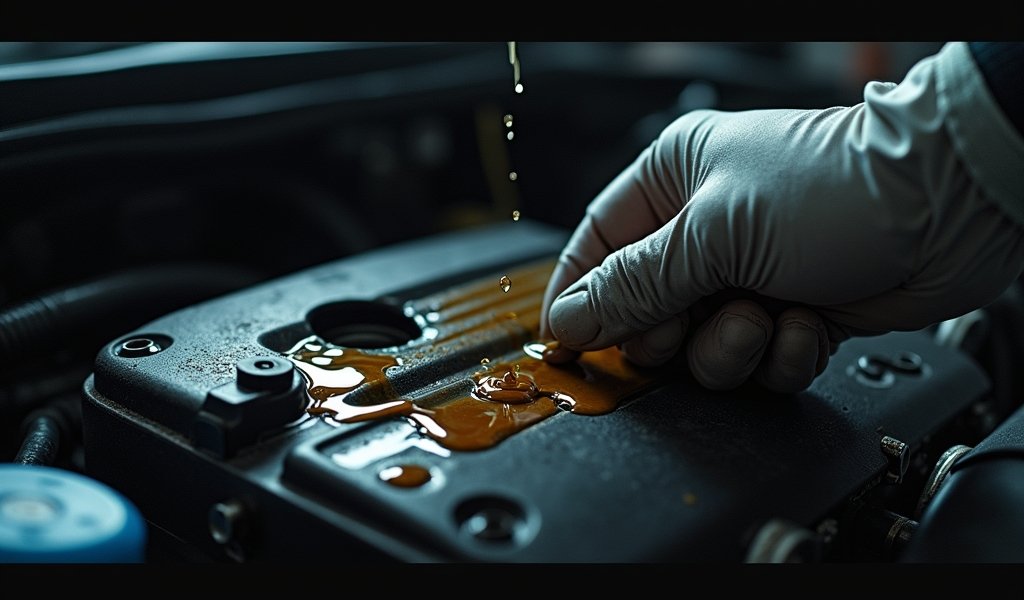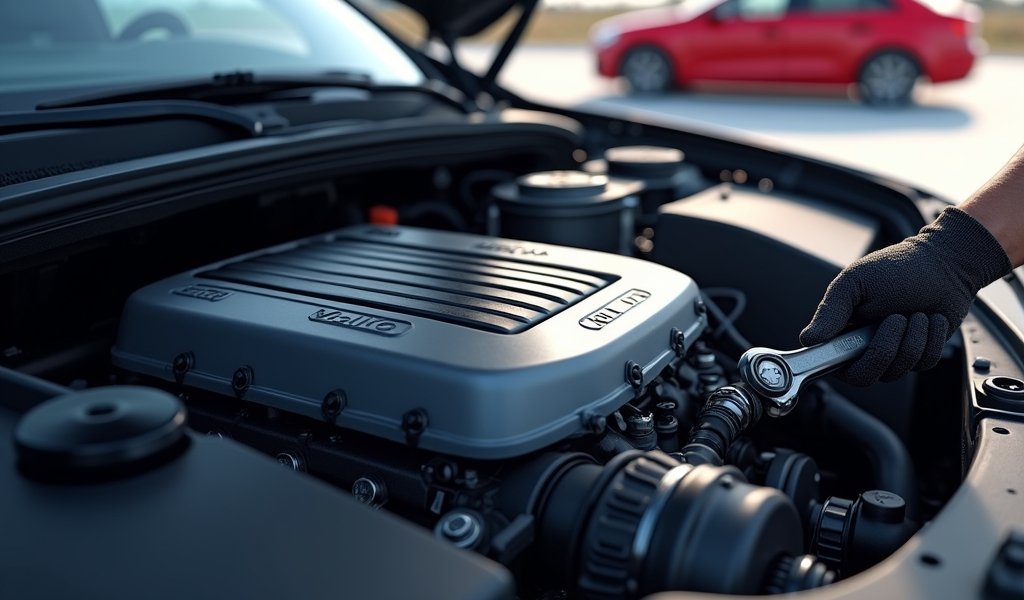Overview
This DIY guide details the complete process for diagnosing and replacing a leaking valve cover gasket, from identifying symptoms (oil spots, burning smells) through the five-step replacement procedure (preparation, removal, cleaning, installation, and testing). The article emphasizes proper cleaning techniques and torque patterns for a successful repair that can save $200-$400 in professional costs, while providing preventative maintenance tips to extend the life of the new gasket.
Table of Contents
- Understanding Valve Cover Gasket Leaks
- Signs of a Leaking Valve Cover Gasket
- Tools and Materials Needed
- Step 1: Preparing Your Vehicle
- Step 2: Removing the Valve Cover
- Step 3: Cleaning and Preparation
- Step 4: Installing the New Gasket
- Step 5: Reassembly and Testing
- Preventative Maintenance Tips
- Conclusion
- Frequently Asked Questions
Understanding Valve Cover Gasket Leaks
Let’s talk about valve cover gasket leaks – one of those pesky problems that can turn your pristine driveway into an oil-spotted mess. If you’ve noticed dark spots under your car or caught that unmistakable burning oil smell when your engine heats up, you might be dealing with a valve cover gasket leak.
The valve cover gasket is essentially a rubber seal that sits between your engine’s valve cover and cylinder head. Its job? Keeping engine oil inside where it belongs while preventing dirt and debris from getting in. Over time, these gaskets can deteriorate due to constant heat cycles, oil degradation, and just plain old age.
While it might seem like just an annoying oil drip, ignoring a valve cover gasket leak can lead to bigger headaches. Leaking oil can land on hot exhaust components (hello, burning smell and potential fire hazard) and gradually lower your oil level, potentially leading to inadequate engine lubrication. The good news? This is a repair you can tackle yourself with some basic tools and a little patience.
Signs of a Leaking Valve Cover Gasket
Before we grab our wrenches, let’s make sure we’re dealing with a valve cover gasket leak. Here are the telltale signs that’ll help you confirm your suspicions:
- Oil spots on your driveway or garage floor, particularly after the car has been parked overnight
- Burning oil smell, especially after the engine has heated up
- Visible oil accumulation on the engine, particularly around the valve cover edges
- Oil-soaked dirt clinging to the valve cover area (oil acts like a dust magnet)
- Low oil level with no other obvious leaks
- In some cases, rough idling or misfires if oil has seeped into spark plug wells
To pinpoint the leak, grab a flashlight and inspect the area where the valve cover meets the cylinder head. The leak typically appears as wet, oily residue along the seam. On some engines, the leak might be more apparent at the corners of the valve cover or near the spark plug tubes.
It’s worth noting that valve cover gasket leaks often get confused with other types of common oil leaks. If the oil appears to be coming from higher up on the engine, you’re likely dealing with a valve cover issue. If it’s lower down, you might want to investigate other potential causes like oil pan gaskets or front seals.

Tools and Materials Needed
Alright, tool time! Before diving into this project, make sure you’ve got everything you need. There’s nothing worse than being elbow-deep in an engine bay and realizing you’re missing something crucial.
Essential Tools:
- Socket set and ratchet (metric or standard, depending on your vehicle)
- Torque wrench (crucial for proper reassembly)
- Screwdrivers (flathead and Phillips)
- Pliers for removing hoses and clips
- Gasket scraper or plastic putty knife (avoid metal scrapers on aluminum surfaces!)
- Clean rags or shop towels
- Small containers for organizing bolts and parts
Materials You’ll Need:
- New valve cover gasket (vehicle-specific – don’t guess on this one)
- Spark plug tube seals (if applicable for your vehicle)
- RTV silicone gasket maker (check your vehicle manual if needed)
- Brake cleaner or acetone for cleaning surfaces
- Engine oil (to top off after repair)
When selecting your gasket, I strongly recommend getting either an OEM (Original Equipment Manufacturer) part or a high-quality aftermarket option from brands like Fel-Pro, Victor Reinz, or Mahle. According to Engine Builder Magazine, using the correct gasket material for your specific engine is crucial for a lasting repair.
Before starting, check your vehicle’s service manual or a reputable online repair database for model-specific instructions. Some vehicles have quirks or special procedures that are important to know before you begin. Your wallet will thank you for this bit of preparation!
Step 1: Preparing Your Vehicle
Safety first, folks! Working on a hot engine is a recipe for burned fingers and colorful language. Make sure your vehicle has been off for at least an hour so everything’s cool to the touch.
Start by disconnecting the negative terminal of your battery. This prevents any accidental electrical shorts while you’re working, and trust me – accidentally triggering the starter while your hand is in the engine bay is not an experience you want.
Next, take some “before” pictures with your phone. This might sound silly, but having reference photos of how everything was connected can be a lifesaver during reassembly. Pay particular attention to any electrical connectors, vacuum lines, or hoses that might need to be disconnected.
If you’re working on a front-wheel drive vehicle with a transverse engine (engine mounted sideways), you might need to remove some additional components to gain access to the valve cover. This could include the air intake system, engine covers, or in some cases, the windshield wiper fluid reservoir.
Take your time with this prep work – rushing here often leads to frustration later. Label any disconnected electrical connectors with masking tape if you’re dealing with multiple similar-looking plugs. Your future self will thank you!
Step 2: Removing the Valve Cover
Now we’re getting to the heart of the operation. With the prep work done, it’s time to actually remove the valve cover and get to that pesky leaking gasket.
First, locate and remove any components mounted directly to the valve cover. On many modern engines, this includes ignition coils and spark plug wires. If you need to remove ignition coils, be gentle and pull them straight up to avoid damaging them or the spark plugs.
Next, find and disconnect the PCV (Positive Crankcase Ventilation) system. This usually involves a valve or hose connected to the valve cover. Gently twist and pull to remove it – don’t yank!
Now for the main event: removing the valve cover bolts. These are typically arranged around the perimeter of the cover. The golden rule here is to loosen them in a spiral pattern, starting from the center and working outward. This prevents warping the valve cover.
Once all bolts are loose, gently lift the valve cover straight up. If it’s stubborn (which it probably will be after years of heat cycles), don’t reach for a prybar! Instead, try gently tapping the edges with a rubber mallet or the handle of a screwdriver. Patience is key – forcing it can damage the mating surfaces.
As you remove the cover, take note of any areas where oil was visibly leaking. This can help you pay special attention to those spots during reassembly. Also, check the condition of the old gasket – is it hardened, cracked, or compressed? These are all signs it was indeed time for replacement.

Step 3: Cleaning and Preparation
With the valve cover off, you’re looking at what might be years of baked-on oil residue and old gasket material. Proper cleaning here is absolutely critical – a perfectly good new gasket will fail if the mating surfaces aren’t clean and smooth.
Start by carefully removing all traces of the old gasket from both the valve cover and the cylinder head. A plastic gasket scraper is your best friend here. If you’re working with an aluminum valve cover or cylinder head (which most modern cars have), avoid metal scrapers like the plague! They’ll create gouges that can lead to new leaks.
For stubborn gasket material, a bit of brake cleaner on a rag can help soften it up. Work patiently and methodically – this isn’t a race. Every bit of old gasket material needs to go.
Once the bulk of the material is removed, thoroughly clean both mating surfaces with brake cleaner or acetone. Spray some on a clean shop towel rather than directly on the engine to avoid getting cleaner where it shouldn’t go. Wipe until your rags come away clean.
While you’re at it, inspect the valve cover itself for any warping or damage. Place it on a known flat surface like a piece of glass or a countertop and see if it rocks. If the valve cover is warped, you might need to replace it entirely or, in some cases, have it professionally machined flat.
This is also the perfect time to check your spark plug tube seals if your engine has them. These small O-rings or rubber gaskets prevent oil from leaking into the spark plug wells. If they’re hardened or damaged, replace them while you’ve got everything apart – this helps avoid common car service mistakes where one problem is fixed only to have another crop up soon after.
Step 4: Installing the New Gasket
Now comes the satisfying part – installing the new gasket and putting everything back together. But hold your horses! This step requires some finesse to ensure a proper seal.
First, dry-fit your new gasket onto the valve cover to ensure it’s the correct part and fits properly. The gasket should sit in the groove of the valve cover without falling out, but also without being stretched or compressed.
If your vehicle’s service manual calls for RTV silicone in certain spots (usually corners or areas with complex shapes), apply a small bead as directed. Don’t go overboard – when it comes to RTV, less is definitely more. A 1/8-inch bead is typically sufficient. Too much silicone can squeeze into places it shouldn’t be, potentially blocking oil passages.
Some gaskets need to be “tacked” into place with a tiny bit of RTV at a few points to keep them from shifting during installation. Others are designed to stay in place on their own. Follow the specific instructions for your vehicle and gasket type.
If your engine uses spark plug tube seals, install them now, making sure they’re seated properly in their grooves. A light coating of oil on these seals can help them slide into place without tearing.
Place the valve cover with the new gasket attached carefully onto the cylinder head, making sure it’s properly aligned. This is where having a helper can be useful – an extra set of hands to help guide everything into place.
According to Motor Trend’s guide on proper torquing, following the correct tightening sequence is crucial for ensuring an even seal. Start by installing all the bolts finger-tight, then begin the tightening sequence, which is typically from the center outward in a spiral pattern.
Step 5: Reassembly and Testing
We’re in the home stretch! With your new gasket installed and valve cover bolts properly torqued, it’s time to put everything else back together and test your repair.
Reconnect all the components you removed earlier, including ignition coils, spark plug wires, the PCV system, and any electrical connectors. This is where those reference photos you took earlier really come in handy. Make sure everything clicks or snaps into place properly – half-connected electrical plugs can cause all sorts of mysterious running issues.
Double-check that all vacuum lines are reconnected and secured. These small hoses can be easy to overlook, but forgetting one can cause performance problems.
Before reconnecting the battery, verify that all tools have been removed from the engine bay. It’s surprisingly easy to leave a socket or screwdriver resting somewhere it shouldn’t be. Once you’re confident everything’s in order, reconnect the negative battery terminal.
Now for the moment of truth: start the engine. Let it idle for a few minutes while you watch for any obvious leaks around the valve cover. No leaks? Great! Turn off the engine and check the oil level, topping off if necessary.
For a thorough test, take your vehicle for a drive to get it up to operating temperature. This allows the gasket to heat up and properly seat. After your drive, park on a clean section of pavement and let the car sit for an hour or so, then check underneath for any signs of leaking oil.
Don’t be alarmed if you still smell burning oil for a day or two after the repair. It’s normal for some residual oil to burn off from surfaces where it spilled during the repair process. This should disappear after a few heat cycles.
Preventative Maintenance Tips
Now that you’ve successfully tackled your valve cover gasket leak, let’s talk about how to prevent future issues. A little preventative maintenance goes a long way in extending the life of your new gasket.
Regular oil changes with the correct type and grade of oil for your vehicle are crucial. Clean, fresh oil is less likely to degrade gasket materials over time. Most mechanics recommend changing oil every 5,000-7,500 miles for conventional oil, or 7,500-10,000 miles for synthetic oil.
Keep an eye on your PCV system. A clogged PCV valve can cause excessive pressure in the crankcase, which can force oil past even a good gasket. These valves are inexpensive and relatively easy to replace as part of your regular maintenance routine.
Avoid prolonged periods of extreme heat. While modern engines are designed to operate at high temperatures, excessive heat accelerates gasket deterioration. If you notice your temperature gauge creeping up, address cooling system issues promptly.
Make it a habit to visually inspect your engine bay every month or so. A quick glance with a flashlight can catch small leaks before they become major problems. Pay special attention to the valve cover area and look for any shiny, wet spots that might indicate a developing leak.
If you’re tackling other engine work that involves removing components near the valve cover, take the opportunity to inspect the gasket while you’re there. These types of gasket replacements often make sense to combine with other maintenance tasks to save time and effort.
Conclusion
Congratulations! You’ve successfully tackled a valve cover gasket leak repair – a job that would likely cost $200-$400 at a repair shop. Beyond the satisfaction of saving money, you’ve gained valuable knowledge about how your engine works and the confidence to handle more maintenance tasks in the future.
Remember that patience is the key to success with this type of repair. Taking your time with the cleaning and preparation steps pays dividends in the longevity of your repair. A properly installed valve cover gasket should last 50,000-100,000 miles under normal driving conditions.
Keep in mind that different engines have different quirks when it comes to valve cover gasket replacement. While the basic principles remain the same, always consult your specific vehicle’s service manual for any model-specific procedures or torque specifications.
By addressing your valve cover gasket leak promptly, you’ve protected your engine from potential damage, maintained proper oil levels, and eliminated that unsightly driveway staining. Plus, you no longer have to worry about that burning oil smell when your engine heats up.
Whether this was your first DIY car repair or just the latest in your growing mechanical skillset, take pride in a job well done. The skills and knowledge you’ve gained here will serve you well in future maintenance projects. Happy driving!
Frequently Asked Questions
How much does it cost to replace a valve cover gasket?
DIY costs typically range from $25-$60 for parts. Professional repair costs between $200-$400 depending on your vehicle make and model.
How long does it take to replace a valve cover gasket?
For a DIY enthusiast, expect to spend 2-3 hours on your first attempt. With experience, this job can be completed in about an hour.
Can I drive with a leaking valve cover gasket?
While not immediately dangerous, driving with a leaking valve cover gasket can lead to oil starvation, electrical issues if oil contacts wiring, and potential fire hazards. Best to fix it promptly.
How long do valve cover gaskets last?
Most valve cover gaskets last between 50,000 to 100,000 miles. Factors affecting longevity include driving conditions, oil change frequency, and engine design.
Will a valve cover gasket leak cause the check engine light to come on?
Not directly, but if oil contaminates oxygen sensors or creates misfires by seeping into spark plug wells, it may eventually trigger warning lights. The primary symptoms are visual leaks and burning oil smell.


Pingback: Valve Stem Seal Replacement Procedure! - knowsyourcar.com